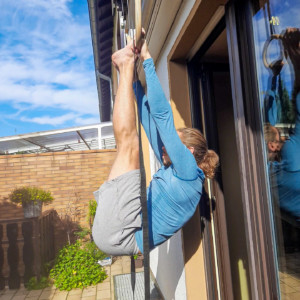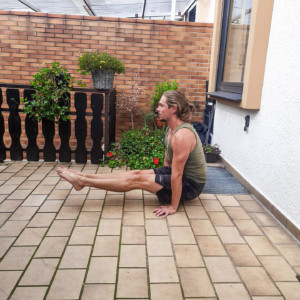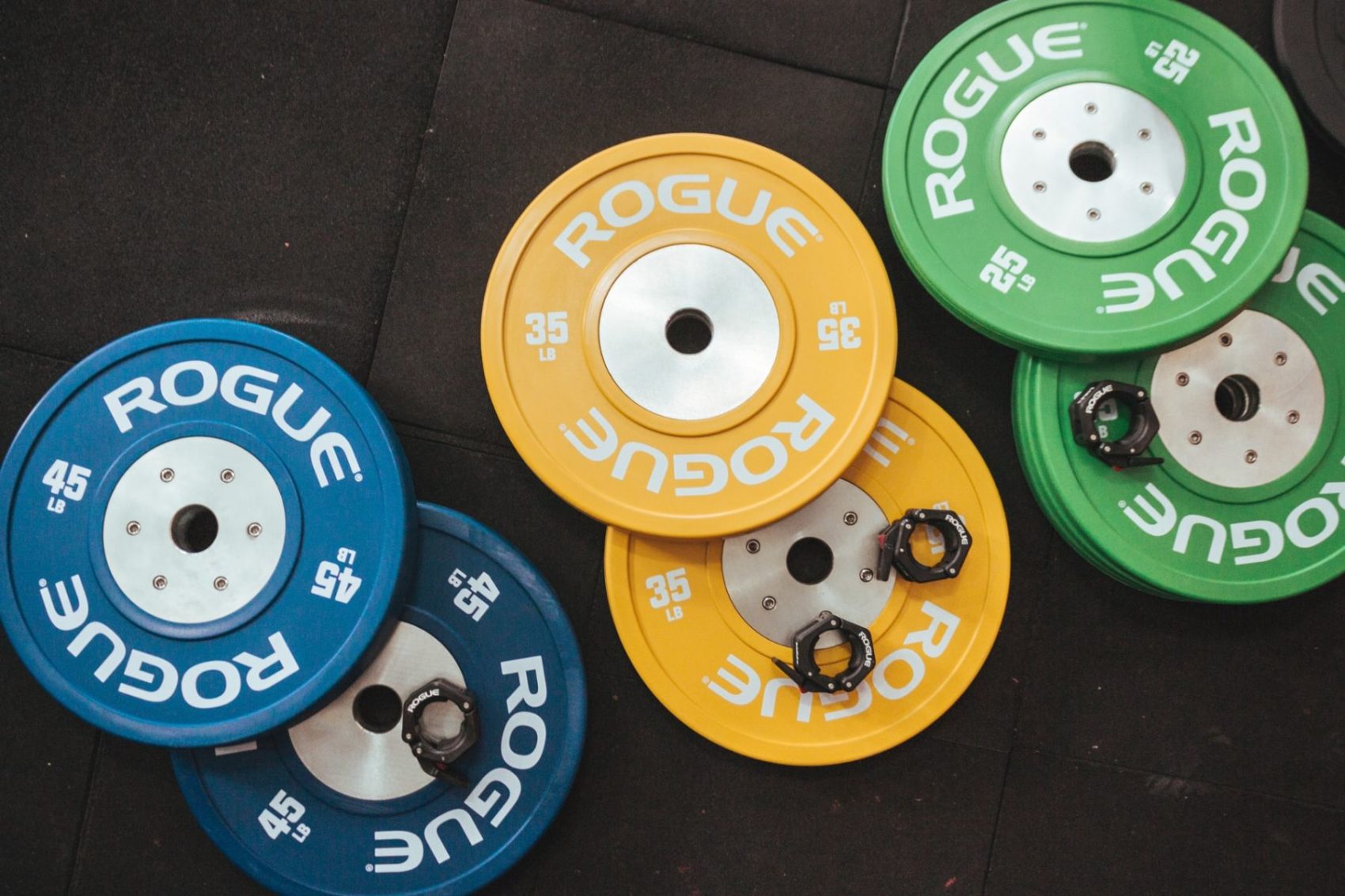Let me contradict a secret wish of many fitness enthusiasts:
The superior goal of your ab training should never be a sixpack. It should be a strong and functional core – rock hard-looking abs are the byproduct of achieving that.
…and one important exercise which can help you achieve that goal are hanging leg raises.
There are a ton of ab exercises – many are really cool, some plainly stupid and others go lost in the dense swamp of exercises. Few offer that many benefits and carryover to different skills as hanging leg raises do.
Let’s take at this post a close look at this awesome, but often totally misunderstood exercise.
The Benefits of Hanging Leg Raises
You expect answers, my dear padawan. But I will ask you a question first: What do you want to achieve by doing hanging leg raises?
You might be tempted to answer: Get abs, man!
But let’s dig deeper than that.
Hanging leg raises are great to improve your compression strength!1 And that carryovers big time to many other movements.
I would go so far that there aren’t many other exercises you need for this job. Forget ab rollers, situps – chalk up*, grab a bar and get your feet up!
Not to say that Ab Rollers* are crap, but they err more on the side of core stability, likewise physioball* core exercises. But that’s a whole ‘nother post!
Common things this exercise can help you with are:
- Mainly your compression strength – it prepares you for l-sits, handstand presses, jumps, flips, v-sits and lookin’ very far down the road – mannas.
- But also your hamstring mobility – yes, you’ve read that one right!
- and finally – get chiseled abs like a greek god.
The proper Technique to learn Hanging Leg Raises
Don’t use Momentum
You see many crossfitters do that. While for their specific purposes this might be legitimate2, for general strength-building purposes it is not optimal.
Control the upward motion, feel your body folding in half. Feel your core and your hip flexors contracting. And now slowly release that tension and go down.3
If you need momentum all the time to do certain progressions, chances are high that you are too weak to truly work on that level. So, put your ego aside and work on an appropriate level.
Don’t perform a Front Lever
This one is another common pitfall. You wanna work your abs right? Not your back?
Many mix the hanging leg raise up with kind of a front lever raise. That takes the strain off your abs and recruits your midback for help.
You don’t want to do this when trying to strengthen your abs. A great video showing explaining this is this video by Gabo Saturno.
To avoid this mistake entirely you should, if available, do the hanging leg raises hanging down from a stall bar.
Think of Folding in Half
Try to smash your feet into your face.
Really, do that! For 99% that won’t be possible and a great cue. If you manage to do that – I am deeply impressed. And sorry for that bruise.

Hanging Leg Raises for Beginners – Floor to Hanging!
Step I: Start out on the Floor

The best starting point strength-wise and technique-wise is the floor. Here you can progress well, learn the technique safely, and can’t cheat.
I would suggest starting out with knee raises, and doing straight leg raises if you are comfortable doing at least 8 beautiful ones. Alternatively, throw some single leg raises and some with your butt up in the air in the mix.
For many explanations and how all of these exercises look like be sure to check out this and the three annexed videos at the end of this article.
Step II: Try out Hanging Knee Raises
If you are comfortable doing at least 8 beautiful leg raises on the floor and hanging down from a bar* or a pair of gymnastic rings* for around 30s without forearm cramps – try out the knee raises!
The key point is here to keep your shoulders active. This way you won’t just rock from front to back while doing these. But – not that active that they do the main work.
Take a look at this video for further clarification. 4
Step III: Utilize Negatives
When you’re comfortable doing somewhat as 5 knee raises with proper form, you can try out some negatives to get a feeling for that move.
Get your feet to the bar using a lot of momentum. Yes, I’ve said you should use momentum. Just in this case!
Now activate your core, your hip flexors, and try to lower your legs as slowly as possible.
With the help of hanging knee raises and negatives, you should work your way up to the full leg raises, in no time!
Step III-B: Work on your Pike Flexibility

One point to consider working on is your pike flexibility. Many are not flexible enough to straighten their legs while doing hanging leg raises.
A pro tip of mine would be to work on your pike flexibility with passive holds of 1-2 minutes in the set breaks between your leg raises.
That combination of active and passive flexibility goes a long way!

How do I program Hanging Leg Raises?
That depends strongly on your weekly workout schedule.
I would suggest working hanging leg raises 2-4 times a week right after your push/pull/legs/upper/lower/whatever sessions.
Do 3-5 sets of 5-12 reps, working in between the sets passively on your pike position. If you are trying to bridge the gap between two levels, lower reps and more sets can be helpful, too. For example, don’t try to crank out 12 negatives – the DOMS the next day will kill you. 😀 Do 3-5 quality lowers of 5-10s each. That’s all I wanted to talk about today with you! I hope that post could clarify some of the most common pitfalls I see and encountered myself.
Now it’s your turn to help me out! How did you like that article? Have you any questions left? Or still struggling with doing leg raises the right way?
Just drop me a line – I would love to hear from you!
Read you soon,

Sources and further reading
- Check out this video by Tom Merrick to learn everything about the hanging leg raise itself and how to progress to full leg lifts properly, starting out with knee raises.
- This Video by Sid Paulson shows you a whole gymnastic routine around the hanging leg lifts and on how to achieve them quickly if you are really serious about achieving that goal.
- This video by FitnessFAQs about the most common mistakes when doing hanging leg raises and how to fix them easily is also a great start point for anyone trying to learn the hanging leg raises.
Footnotes
- Compression strength is the strength your core has to get your legs as close as possible towards your upper body.
- I don’t know much about CrossFit specific programming, that’s why I want to leave this open and don’t wanna claim it to be false, what they are doing. If you know something more about it – tell me I always like to learn, too!
- Do hanging leg raises like you would do biceps curls. Either you wouldn’t throw your weights up ‘n’ down. Go forcefully and controlled up, and slowly back down.
- To internalize that takes just some time. Everybody starts out fucking around and barely getting his knees properly up without swinging like a drunk monkey. You got this!


